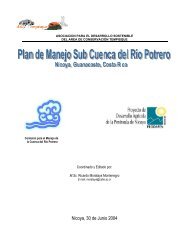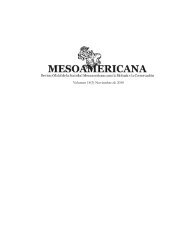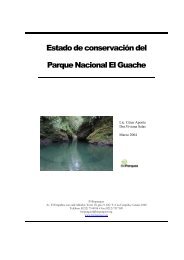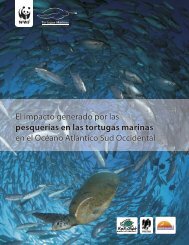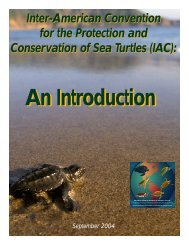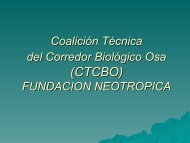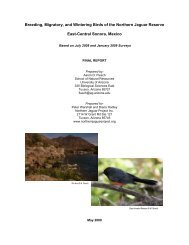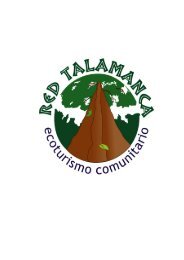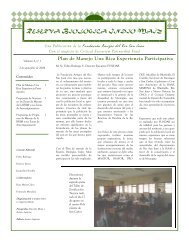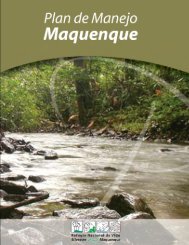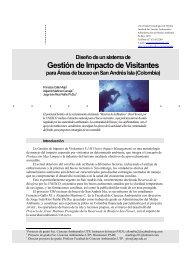Oportunidades en la S<strong>el</strong>va Maya:calidad de vida que dependede la naturalezaEl desarrollo económico y la calidad de vida de lapoblación dependen de la diversidad y de lariqueza natural de la S<strong>el</strong>va Maya. Por eso, laconservación de la naturaleza es vital <strong>para</strong> mejorarlas condiciones socio-económicas de esta región y<strong>para</strong> atenuar los impactos de los desastresnaturales.El turismo cultural y de playa, <strong>el</strong> desarrollo forestaly la producción de agua – actividadesfundamentales <strong>para</strong> <strong>el</strong> desarrollo económico de laregión – dependen de que se conserven lacobertura forestal, las sabanas, los humedales y lasplayas, ríos y lag<strong>una</strong>s de la zona.El turismo, después de la industria petrolera, es laactividad económica más importante de la región,generando más de US$ 5,000 millones anualessolamente en la S<strong>el</strong>va Maya. Alrededor de 18millones de turistas, nacionales y extranjeros,visitaron esta zona de gran desarrollo turístico en2004, debido al atractivo que generan las playas yarrecifes d<strong>el</strong> Caribe (B<strong>el</strong>ice y Quintana Roo), lasciudades Mayas (Tikal, Chichen Itzá, Uxmal, Tulúm,Palenque, entre otras) y sus ciudades (Cancún,Mérida y Veracruz).El aporte económico d<strong>el</strong> turismo se destaca en <strong>el</strong>Estado de Quintana Roo, donde 6,7 millones deturistas extranjeros dejaron US$ 3,280 millones en2004. A <strong>el</strong>lo hay que agregar los aportes de los 4,1millones de turistas nacionales que tambiénvisitaron la Riviera Maya en ese año. Mientras tantoen B<strong>el</strong>ice, 200 mil visitantes generaron US$ 156millones, lo cual representa <strong>el</strong> 30% de las divisasd<strong>el</strong> país. En Guatemala más de 120,000 turistasvisitan anualmente <strong>el</strong> Parque Nacional Tikal.En materia de desarrollo forestal, la S<strong>el</strong>va Mayatambién ofrece oportunidades importantes. Lasconcesiones forestales comunitarias certificadasmás grandes de Mesoamérica se encuentran en <strong>el</strong>Petén guatemalteco, así como grandes ejidosforestales en México, que son ejemplo de buenmanejo de los bosques y que redundan enbeneficios <strong>para</strong> sus propietarios y <strong>para</strong> laconservación de la biodiversidad. En la Reservade Biosfera Maya, en Guatemala, se hanconcesionado más de 500,000 hectáreas debosque de la zona de uso múltiple acomunidades locales y a concesionariosindustriales. De éstas, 350,000 hectáreas hansido certificadas por <strong>el</strong> Forest StewardshipCouncil (FSC).Servicios ambientales como producción deagua, fijación de carbono, reducción devulnerabilidad ante fenómenos ambientales yb<strong>el</strong>leza escénica, entre otros, son parte de losbeneficios que brinda la S<strong>el</strong>va Maya. Estaregión genera un tercio d<strong>el</strong> agua de México<strong>para</strong> consumo humano, agrícola y energético,constituyéndose en <strong>una</strong> zona estratégica <strong>para</strong>este país. En la Península de Yucatán losbosques y los humedales son críticos yesenciales <strong>para</strong> regular los ciclos hídricos. Laubicación de las costas d<strong>el</strong> Caribe mexicano yb<strong>el</strong>iceño las hace vulnerables al impacto detormentas y huracanes, provocando grandesdaños a la economía local y regional. Lacobertura de los humedales costeros ayuda aamortiguar <strong>el</strong> efecto dañino de estosfenómenos ambientales.Tomando en cuenta todos estos beneficiossocioeconómicos que brinda la S<strong>el</strong>va Maya, nocabe duda que la industria turística, la forestaly los proveedores y usuarios d<strong>el</strong> agua, entreotros, constituyen fuertes aliados <strong>para</strong> laconservación de la biodiversidad.8
Opportunities in the MayaForest: Quality of Life thatDepends on Nature<strong>Eco</strong>nomic dev<strong>el</strong>opment and the population’s qualityof life depend on the diversity and natural wealth ofthe Maya Forest. Conservation is thus vital to improvesocioeconomic conditions in this region and to bufferthe impacts of natural disasters.Cultural and beach tourism, forestry dev<strong>el</strong>opment andthe production of water – essential activities for theregion’s economic dev<strong>el</strong>opment – depend onpreserving the forest cover, the savannas, thewetlands, the beaches, rivers and ponds of the zone.After the oil industry, tourism is the most importanteconomic activity in the region, generating more thanUS$ 5 billion a year in the Maya Forest alone. Around18 million national and foreign tourists visited this toptourism zone in 2004, attracted by Caribbean beachesand reefs (B<strong>el</strong>ize and Quintana Roo), Mayan cities(Tikal, Chichen Itzá, Uxmal, Tulúm, Palenque and othersites) and modern-day cities (Cancun, Merida andVeracruz).The economic contribution of tourism isunderscored in the state of Quintana Roo, where6.7 million foreign tourists spend nearly US$ 3.28million in 2004. To this must be added revenuesfrom the 4.1 national tourists who also visited theMayan Riviera that year. In B<strong>el</strong>ize, meanwhile, 200thousand visitors generated US$1.56 million,which represented 30% of the country’s foreignearnings. In Guatemala more than 120,000tourists visit Tikal National Park each year.S<strong>el</strong>va Maya also offers important opportunities inthe area of forestry. Mesoamerica’s largestcertified forest concessions are located in theGuatemalan Petén, and the large forest ejidos inMexico demonstrate how sound forestmanagement can benefit owners and conservebiodiversity. In the Maya Biosphere Reserve, inGuatemala, there are more than 500,000hectares of forest in the multiple-use area undercommunity and industrial concession. Of these,350,000 hectares have been certified by theForest Stewardship Council (FSC).Environmental services such as water, carbonsequestration, reduction of vulnerability toenvironmental phenomenon, scenic beauty andothers are part of the benefits provided by theMaya Forest. This region generates one-third ofMexico’s water supply for human, agricultural andenergy consumption, making this a highlystrategic area for the country. In the YucatanPeninsula, forests and wetlands are critical andessential for regulating water cycles. The locationof the Caribbean coasts of Mexico and B<strong>el</strong>izemakes them vulnerable to the impacts of stormsand hurricanes, with huge costs to the local andregional economy. Coastal wetland cover h<strong>el</strong>psbuffer the damaging effect of theseenvironmental phenomenon.Given all of these socioeconomic benefits, there isno doubt that the tourism industry, the forestryindustry, providers and users of water and othersconstitute strong allies for the conservation ofbiodiversity.9




